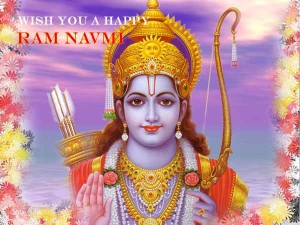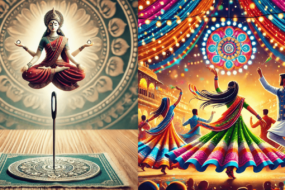Lord Rama was born on Navami Tithi during Shukla Paksha of Chaitra month. Each year this day is celebrated as the birthday of Lord Rama. All across India, the day of Ram Navami is celebrated as the birthday of the Lord Ram, one of the most familiar and loved deities in the Hindu pantheon. Lord Ram is known as the seventh incarnation of the Dashavatara of Vishnu and was born to the Dasharatha and Queen Kausalya of Ayodhya. The Ram Navami festival falls in the Shukla Paksha on the Navami, the ninth day of the month of Chaitra according to the Hindu calendar.
The nine days leading up to Ram Navami are days of fasting and prayer for the devout, and the day of the festival itself is marked by pujas and satsangs (public gatherings). The period is also known as Shri Rama Navratra.
Lord Rama was born during Madhyahna period which is middle of Hindu day. Madhyahna which prevails for six Ghatis (approximately 2 hours and 24 minutes) is the most auspicious time to perform Rama Navami Puja rituals. The mid-point of Madhyahna marks the moment when Shri Rama was born and temples symbolize this moment as birth moment of Lord Rama. The chanting of Shri Rama and celebration reaches its peak during this time.

Due to the widespread use of the western clock and Gregorian calendar, people assume 12 p.m. as Madhyahna moment. This could have been correct if sunrise and sunset occur exactly at 6 a.m. and 6 p.m. respectively but at most places, sunrise and sunset timings are different from six O’clock. Hence the exact time to celebrate the birthday of Lord Rama falls between 11 a.m. and 1 p.m. for most Indian cities. DrikPanchang.com list Hindu midday moment for all cities and this moment should be used to mark the birth of Shri Rama.
Ayodhya is the birthplace of Lord Rama and Rama Navami celebrations in Ayodhya are remarkable. Devotees come to Ayodhya from far-flung places. After taking a holy dip into river Sarayu Devotees visit Rama temple to participate in birthday celebrations.
Eight Prahar fasting is suggested during Rama Navami. Which means devotes should observe the fast from sunrise to sunrise. Rama Navami Vrat can be observed in three different ways, casual (नैमित्तिक) -which can be observed without any cause, continual (नित्य) – which can be observed throughout life without any desire and desirable (काम्य) – which can be observed to fulfill any desire.



